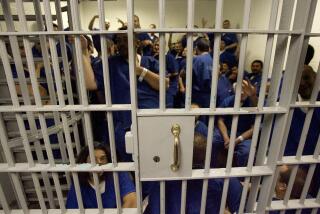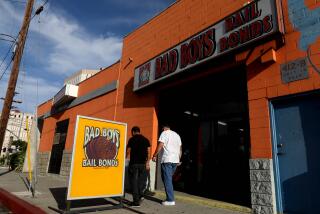History Lives at World’s Best-Known Courthouse
LONDON — In the dim and deplorable past, a prisoner refused to plead guilty to murder at Old Bailey.
An infuriated judge ordered: “He be laid on his back, that his arms be stretched with a cord, and in like manner his legs, and that upon his body shall be laid as much iron and stone as he can bear, and more, and this shall be his punishment until he die.”
The prisoner was thus tortured in the Press Yard of infamous Newgate Prison, then on the Old Bailey site. His friends added their own bodies to the weights to hasten his death and relieve him of his pain.
That was England of the 17th Century, and such Draconian horrors were not unusual. Children were hanged for theft. One wretch received seven years’ banishment to Africa for stealing a handkerchief. The accused were considered guilty until acquitted.
Sentences included whipping, branding and jailing in appalling conditions--starvation, crowding, filth, depravity and cold.
Deadly for All
To combat the stomach-wrenching stench, vinegar fumes were pumped into the court and the justices were issued nosegays. One outbreak of “gaol fever” (typhus) in 1750 took 50 lives, including the Lord Mayor, two judges and a sheriff.
Old Bailey’s real name is the Central Criminal Court of England. Old Bailey is its street.
The original structure was replaced in 1423 but was destroyed by the Great Fire of 1666. Rebuilt, it continued to be a cesspool of filth and inhuman treatment.
In 1774 the first proper courthouse was raised, and the oldest part of the present complex was dedicated by Edward VII in 1907.
It is called The Bailey by almost everyone, and its senior chamber has become the most celebrated criminal courtroom in the world. The martyred Sir Thomas More was once its “governor.” Here were tried Guy Fawkes, Daniel Defoe and William Penn.
More recently it has staged the dramas surrounding Oscar Wilde, Lord Haw Haw and the Yorkshire Ripper.
Traditional Garb
The Bailey serves London and parts of neighboring counties, so on any day its 19 courts are theaters wherein bewigged barristers and pin-striped solicitors debate the fates of accused murderers, rapists and thieves from a population of more than 8 million.
The Bailey dominates its prosaic byway near the end of Fleet Street and almost in the shadow of St. Paul’s Cathedral. The granite and stone courthouse might be any other office block at London’s financial heart were it not for the dome atop its 1907 portion with its gilded statue of Justice.
In this case the lady is not blindfolded, the British belief being that justice should have full sight.
Beneath her feet lies the massively marbled hall of the older building, with its murals depicting milestones in jurisprudence such as Moses and the divine laws, Roman Law, King Alfred and the Magna Charta.
Immediately across the street is the Magpie and Stump public house, which once charged hefty fees to watch public hangings from its upper windows. The last of these spectacles was in 1868. (Peers were strung up with a silver cord, commoners with plain rope.)
Bailey regulars still frequent the pub for twilight refreshment and critiques.
Populated With Witnesses
The Bailey is entered through an unadorned lower hall, populated like any other outer court with witnesses, attorneys and relatives of the accused.
In the historic oak-paneled Number-One Court, the defendant sits in a glassed-in dock accompanied only by a prison officer. The wigged and black-gowned barristers speak for their clients; solicitors perform only in advisory capacities.
The red-robed senior judge presides from a dais under a golden sword presented to the Lord Mayor by the Cutlers Co. in 1753.
No one is armed at the Bailey except its undersheriff-administrator, who wears a sword during traditional morning ceremonies when the courts are opened. The cutlass is never carried in the afternoon, ever since a long-ago sheriff prodded a judge after lunch.
Proceedings are subdued. One is struck by the civility, the frequency of such expressions as “May it please your lordship,” and “If you will be so kind,” often directed to the most unsavory ruffian in the dock.
There are sections of the Bailey that the public rarely sees. Behind the courts is the sheriffs’ hall with its tastefully appointed offices, rows of oil paintings and air of efficiency and courtesy.
Holding Cells
Two flights below is a less-hospitable scene: 70 holding cells to which defendants are taken to their trials from other confinement. A few of the cubicles have not been modernized, and remain coffin-like cavities with a single pallet.
Here too is Dead Man’s Walk, a dank and dark passageway along which thousands stumbled to the gallows.
Today the Bailey is a 1980s temple of compassionate justice, its days of infamy living only in legend.
At 1 p.m. the justices retire in their robes and wigs to sip a sociable glass of sherry or fruit juice and have lunch. The long room is warmly lighted, its walls lined with the escutcheons of past justices and signed portraits of the royal family.
Talk is light and humor-tinged--of cricket, travel, children, gardening and that mainstay of British conversation, the weather.
There is scant mention of the grim business to which they will return, the enormous weight of the Bailey’s drama, the lives that are hourly being ruined, revenged, reshaped or salvaged.
On surrounding streets the city’s ubiquitous snack bars do brisk business. Some of their customers nibbling submarine sandwiches wear the wigs of centuries of tradition.
Spectator galleries at the Old Bailey are open to the public from 10 a.m. to 1 p.m. and from 2 to 4 p.m. on a first-come basis. No children are admitted.
More to Read
Sign up for Essential California
The most important California stories and recommendations in your inbox every morning.
You may occasionally receive promotional content from the Los Angeles Times.










